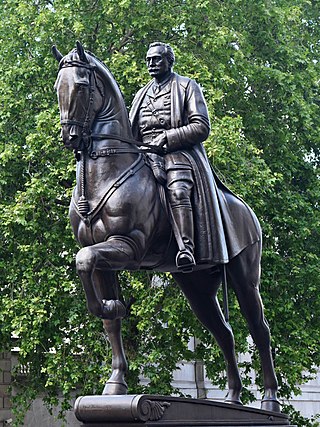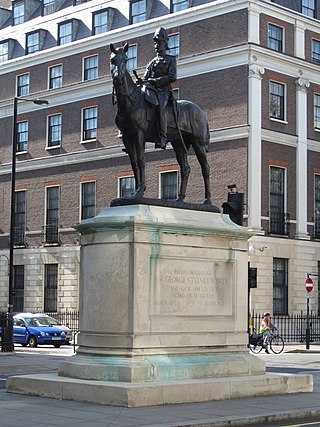
Horse Guards Parade is a large parade ground off Whitehall in central London. It is the site of the annual ceremonies of Trooping the Colour, which commemorates the monarch's official birthday, and the Beating Retreat.

The Earl Haig Memorial is a bronze equestrian statue of the British Western Front commander Douglas Haig, 1st Earl Haig on Whitehall in Westminster, London. It was created by the sculptor Alfred Frank Hardiman and commissioned by Parliament in 1928. Eight years in the making, it aroused considerable controversy; the Field Marshal's riding position, his uniform, the horse's anatomy and its stance all drew harsh criticism. The inscription on the plinth reads 'Field Marshal Earl Haig Commander-in-Chief of the British Armies in France 1915–1918'.

Southport War Memorial is in London Square, Lord Street, Southport, Merseyside, England. It consists of an obelisk flanked by two colonnades in the form of Greek temples. Outside the colonnades are memorial gardens, each containing a Pool of Remembrance and fountains. The memorial was designed by the local architects Grayson and Barnish, and the carving was executed by Herbert Tyson Smith. It was unveiled in 1923 by the Earl of Derby. Following the Second World War and subsequent conflicts further inscriptions and names have been added. The memorial is recorded in the National Heritage List for England as a designated Grade II* listed building.

The Guards Memorial, also known as the Guards Division War Memorial, is an outdoor war memorial located on the west side of Horse Guards Road, opposite Horse Guards Parade in London, United Kingdom. It commemorates the war dead from the Guards Division and related units during the First World War, and of the Household Division in the Second World War and other conflicts since 1918.

The equestrian statue of the Viscount Wolseley is an outdoor sculpture depicting Garnet Wolseley, 1st Viscount Wolseley, located at the Horse Guards Parade in London, United Kingdom. It is by Sir William Goscombe John and was unveiled by the Duke of Connaught in 1920. The front of the plinth contains an inscription which reads "Wolseley", while the back includes the inscription: "Field-Marshal Viscount Wolseley, KP, GCB, OM, GCMG, 1833–1913, Commander-in-Chief of the British Army, 1895–1900. / Burmah 1852–3 / Crimea 1854–5 / Indian Mutiny 1857–9 / China 1860–1 / Red River 1870 / Ashanti 1873–4 / South Africa 1879 / Egypt 1882 / Soudan 1884–5."

The Imperial Camel Corps Memorial is an outdoor sculpture commemorating the Imperial Camel Corps, located in Victoria Embankment Gardens, on the Thames Embankment to the east of Charing Cross station, in London, England. The unit of mounted infantry was created in December 1916 from troops that had served in the Gallipoli campaign in the Dardanelles.

The equestrian statue of George Stuart White is a Grade II listed outdoor bronze sculpture depicting Field Marshal Sir George Stuart White, an officer of the British Army, located in Portland Place, London, England. The sculptor was John Tweed and the statue was unveiled in 1922.

The Royal Marines Memorial, also known as the Graspan Royal Marines Memorial, is an outdoor bronze sculpture by Adrian Jones, installed on the north side of The Mall in London, United Kingdom. Located next to Admiralty Arch, the 1903 memorial commemorates the Royal Marines who died in the Boxer Rebellion in China and the Second Boer War in Africa, and depicts two figures on a Portland stone plinth.

A bronze statue of Admiral of the Fleet Louis Mountbatten, 1st Earl Mountbatten of Burma is located on Mountbatten Green, off Horse Guards Road, Whitehall, London, England. The sculptor was Franta Belsky and the work was cast by the Meridian Bronze Foundry. The memorial was unveiled on 2 November 1983.

The London Troops War Memorial, located in front of the Royal Exchange in the City of London, commemorates the men of London who fought in World War I and World War II.

The Portsmouth Naval Memorial, sometimes known as Southsea Naval Memorial, is a war memorial in Portsmouth, Hampshire, England, on Southsea Common beside Clarence Esplanade, between Clarence Pier and Southsea Castle. The memorial commemorates approximately 25,000 British and Commonwealth sailors who were lost in the World Wars, around 10,000 sailors in the First World War, and 15,000 in the Second World War. The memorial features a central obelisk, with names of the dead on bronze plaques arranged around the memorial according to the year of death.

The Cavalry of the Empire Memorial, also known as the Cavalry Memorial, is a war memorial in Hyde Park, London. It commemorates the service of cavalry regiments in the First and Second World Wars. It became a Grade II listed building in 1987, and was promoted to Grade II* in November 2014.

Paternoster, also known as Shepherd and Sheep or Shepherd with his Flock, is an outdoor bronze sculpture of 1975 by Elisabeth Frink, installed in Paternoster Square near St Paul's Cathedral in London, United Kingdom.

The Thames Ditton Foundry was a foundry in Thames Ditton, Surrey, which operated from 1874 to 1939 and which under various owners produced numerous major statues and monuments as one of the United Kingdom's leading firms of bronze founders.

The Royal Artillery Boer War Memorial is located on the south side of The Mall in Central London, close to the junction with Horse Guards Road at the northeast corner of St James's Park. Unveiled in 1910, it marks the deaths of the 1,083 soldiers of the Royal Artillery who died in the Second Boer War from 1899 to 1902 It has been a listed building since 1970.

The Equestrian statue of Ferdinand Foch stands in Lower Grosvenor Gardens, London. The sculptor was Georges Malissard and the statue is a replica of another raised in Cassel, France. Foch, appointed Supreme Commander of the Allied Forces on the Western Front in the Spring of 1918, was widely seen as the architect of Germany's ultimate defeat and surrender in November 1918. Among many other honours, he was made an honorary Field marshal in the British Army, the only French military commander to receive such a distinction. Following Foch's death in March 1929, a campaign was launched to erect a statue in London in his memory. The Foch Memorial Committee chose Malissard as the sculptor, who produced a replica of his 1928 statue of Foch at Cassel. The statue was unveiled by the Prince of Wales on 5 June 1930. Designated a Grade II listed structure in 1958, the statue's status was raised to Grade II* in 2016.

A bronze statue of General Charles George Gordon by Hamo Thornycroft stands on a stone plinth in the Victoria Embankment Gardens in London. It has been Grade II listed since 1970. A similar statue stands at Gordon Reserve, near Parliament House in Melbourne, Australia, on its original tall plinth.

A bronze statue of Mahatma Gandhi by Fredda Brilliant was unveiled in 1968 at the centre of Tavistock Square in London, to mark the impending centenary of Gandhi's birth in 1869. Mahatma Gandhi had studied law at University College London nearby from 1888 to 1891, before being called to the bar at the Inner Temple.

Twickenham War Memorial, in Radnor Gardens, Twickenham, London, commemorates the men of the district of Twickenham who died in the First World War. After 1945, the memorial was updated to recognise casualties from the Second World War. The memorial was commissioned by Twickenham Urban District Council in 1921. It was designed by the sculptor Mortimer Brown, and is Brown's only significant public work. The memorial is unusual for its representation of a jubilant soldier returning home. It became a Grade II* listed structure in 2017.





















